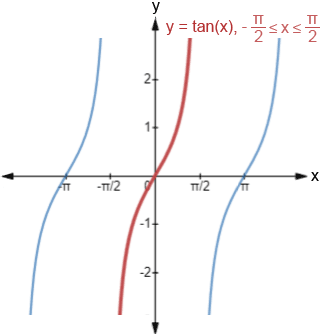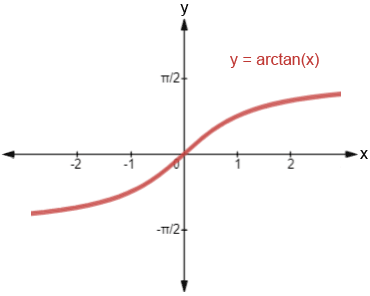How To Find Arctan Of A Number
Arctan
Arctangent, written every bit arctan or tan-i (not to be confused with ) is the inverse tangent function. Tangent just has an inverse function on a restricted domain,
<ten<
. In the figure below, the portion of the graph highlighted in red shows the portion of the graph of tan(x) that has an inverse.

The domain must be restricted because in order for a function to have an inverse, the office must be ane-to-1, meaning that no horizontal line tin intersect the graph of the function more than once. Since tangent is a periodic function, without restricting the domain, a horizontal line would intersect the office periodically, infinitely many times.
Ane of the properties of inverse functions is that if a signal (a, b) is on the graph of f, the point (b, a) is on the graph of its inverse. This effectively means that the graph of the inverse function is a reflection of the graph of the function across the line y = x.
The graph of y = arctan(x) is shown below.

As can exist seen from the figure, y = arctan(x) is a reflection of tan(10), given the restricted domain <x<
, beyond the line y = ten. The domain of arctan(ten), -∞<ten<∞, is the range of tan(10), and its range,
<x<
, is the domain of tan(ten).
Arctan calculator
The following is a calculator to notice out either the arctan value of a number or tangent value of an bending.
Using special angles to observe arctan
While we can observe the value for arctangent for whatsoever 10 value in the interval [-∞, ∞], in that location are sure angles that are used ofttimes in trigonometry (0°, 30°, 45°, 60°, ninety°, and their multiples and radian equivalents) whose tangent and arctangent values may be worth memorizing. Below is a table showing these angles (θ) in both radians and degrees, and their respective tangent values, tan(θ).
| θ | -90° | -60° | -45° | -30° | 0° | thirty° | 45° | 60° | 90° |
| tan(θ) | undefined | | -i | | 0 | | 1 | | undefined |
To find tan(θ), we either demand to simply memorize the values, or remember that tan(θ)= , and determine the value for tan(θ) based on the sine and cosine values, which follow a pattern that may exist easier to memorize. Refer to their respective pages to view a method that may assistance with memorizing sine and cosine values.
Once we've memorized the values, or if we have a reference of some sort, it becomes relatively simple to recognize and determine tangent or arctangent values for the special angles.
Example:
Find arctan() and arctan(-i).
,
.
,
.
Inverse properties
Generally, functions and their inverses exhibit the relationship
f(f-i(x)) = x and f-1(f(ten)) = x
Given that x is in the domain of the part. The aforementioned is true of tan(x) and arctan(x) inside their respective restricted domains:
tan(arctan(x)) = x, for all x
and
arctan(tan(x)) = x, for all x in (,
)
These properties allow u.s. to evaluate the composition of trigonometric functions.
Limerick of arctangent and tangent
If x is inside the domain, evaluating a limerick of arctan and tan is relatively simple.
Examples:
Limerick of other trigonometric functions
Nosotros can likewise make compositions using all the other trigonometric functions: sine, cosine, cosecant, secant, and cotangent.
Case:
Find sec(arctan()).
Since is non one of the ratios for the special angles, nosotros can use a right triangle to observe the value of this composition. Given arctan(
) = θ, we can notice that tan(θ) =
. The right triangle below shows θ and the ratio of its opposite side to its adjacent side.

To find secant, we demand to find the hypotenuse since sec(θ)=. Let c be the length of the hypotenuse. Using the Pythagorean theorem,
12 + 2ii = c2
5 = c2
c =
Nosotros know that arctan() = θ, and then nosotros tin rewrite the problem and find sec(θ) by using the triangle nosotros constructed above and the fact that sec(θ) =
:
sec(arctan()) = sec(θ) =
The same process can be used with a variable expression.
Instance:
Find sin(arctan(3x)).
Given arctan(3x) = θ, we can detect that tan(θ) = and construct the following triangle:

To find sine, we demand to discover the hypotenuse since sin(θ)=. Let c be the length of the hypotenuse. Using the Pythagorean theorem,
(3x)ii + 1two = c2
9x2 + 1 = ctwo
c =
and
sin(arctan(3x)) = sin(θ) =
Using arctan to solve trigonometric equations
Arctangent tin also be used to solve trigonometric equations involving the tangent function.
Examples:
Solve the post-obit trigonometric equations for x where 0≤x<2π.
one. 3tan(x) =
3tan(10) =
tan(x) =
ten = arctan()
Tangent is positive in 2 quadrants, quadrants I and 3, so there are two solutions: x = and 10 =
. These are the simply 2 angles within 0≤x<2π whose tangent value is equal to
.
2. tan2(10) - tan(x) = 0
tantwo(x) - tan(x) = 0
tan(x)(tan(ten) - ) = 0
tan(ten) = 0 or tan(x) - = 0
tan(10) = 0 or tan(x) =
10 = 0, π or x =
Source: https://www.math.net/arctan
Posted by: strattonthemy1953.blogspot.com

0 Response to "How To Find Arctan Of A Number"
Post a Comment